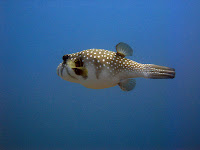Sitting down to learn 150 fish species in the boiling midday heat might not seem like the most inviting way to spend an afternoon(napping for example would be a preferred alternative) but having quickly learnt all the coral types we have to know and appreciating my dives so much more when i can id everything i see, there is definite motivation to push through with the fish. One fish test down, three to go, but diving is becoming more and more enjoyable as we can swim along and know what all the different fish are. I have already developed a number of favourites: the three-spot dascyllus(the first fish i saw on my very first dive in Andava) and the black saddled toby (mainly because i think they are very cool!) and the two dartfish species found here (normally found in pairs- sweet, and very recognisable). Seeing them underwater certainly helps you to remember them, and in this respect I am fortunate because of the daily diving to some truly fantastic sites. Science really is made fun during a BV expedition and the personal gains from learning the fish and benthic species are incentive enough to encourage studying in your spare time. This may sound trite when you’re 9,000 miles away sitting in an office or library trying to work, but on location here in Andava work takes on a whole new meaning. There are numerous tools employed by the field scientists on site to aid fish learning, one of which is a daily presentation by one of the volunteers about a particular fish family to the rest of the group after lunch and dinner. Here follows a small ode to some of the fish in my allocated families used as a memory tool:
Sophie Benbow, Field Scientist


